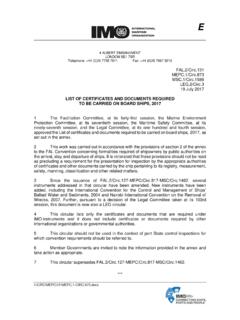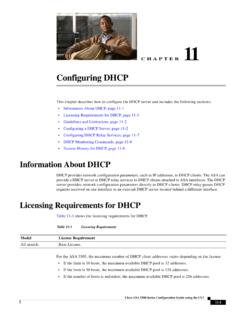Transcription of VESSEL GENERAL PERMIT - United States Environmental ...
1 VESSEL GENERAL PERMIT United States Environmental Protection Agency Office of Water, Office of Wastewater Management Does this PERMIT apply to me? The VESSEL GENERAL PERMIT (VGP) applies to discharges incidental to the normal operation of all non-recreational, non-military vessels of 79 feet or greater in length which discharge in waters of the United States . In addition, the ballast water discharge provisions also apply to any non-recreational VESSEL of less than 79 feet or commercial fishing VESSEL of any size discharging ballast water. Why must I comply? Due to a 2006 court order, all non-recreational, non-military vessels must have an NPDES PERMIT such as the VGP before they can legally discharge (and operate) in US waters.
2 Failure to have NPDES PERMIT coverage may result in severe civil and criminal penalties. What is generally required? The VGP requires that VESSEL owners and operators meet certain requirements, including seeking coverage for most vessels, assuring their discharges meet effluent limits and related requirements, corrective action process for fixing PERMIT violations, and requirements for inspections, monitoring, recordkeeping and reporting. These requirements include: Submission of a Notice of Intent (NOI): If your VESSEL is greater than or equal to 300 gross tons or the VESSEL has the capacity to hold or discharge more than 8 cubic meters (2113 gallons) of ballast water, you must submit a complete and accurate NOI.
3 See Part 10 of the VGP for more information. o If your VESSEL is less than 300 gross tons and has the capacity to carry less than 8 cubic meters of ballast water, but is larger than 79 feet, you need not submit an NOI, but your VESSEL must still comply with all applicable provisions of the VGP. Corrective Actions: If you violate any of the limits in the VGP, you must conduct a corrective action assessment investigating the nature, cause, and potential options for eliminating the problems. Depending upon the extent of the problem, the VGP provides deadlines for resolving the issues.
4 See Part 3 of the VGP for a full description of the corrective action process. Routine Visual Inspections and Annual Inspections: You must conduct routine visual inspections of all accessible areas of the VESSEL in order to verify that effluent limits are being met. A more comprehensive annual inspection must be conducted once every 12 months. The findings of each routine visual inspection and annual inspection must be documented in the official ship logbook or as a component of other recordkeeping documentation. See Parts and of the VGP for specifics. Reporting: All VESSEL owners or operators must submit a one-time report between June and December of 2011.
5 Cruise ships and vessels with ballast water treatment systems must submit analytical data to EPA and/or the US Coast Guard. If vessels have any instances of noncompliance, they must report those instances of noncompliance to EPA annually. Please see Parts , , , and of the VGP for specifics. Environmental Protection Agency, Office of Water EPA-833-11-002 February 2011 Environmental Protection Agency, Office of Water EPA-833-11-002 February 2011 What are examples of the VGP s effluent limits? The PERMIT contains effluent limits for different types of discharges including ballast water, deck runoff, bilge water, and gray water.
6 Here are some examples of limits (see Parts 2 and 5 of the VGP for complete lists): Ballast water discharges - Key Ballast water requirements include: o All US Coast Guard s mandatory ballast water management and exchange standards. o Any VESSEL engaged in Pacific nearshore voyages that carries ballast water that was taken on in areas less than 50 nautical miles from shore must conduct ballast water exchange. o All vessels coming from outside the US EEZ and engaged in pacific nearshore voyages declaring No Ballast On Board (NOBOB vessels) must conduct saltwater flushing if they will discharge in any US waters.
7 O No sediment from ballast water tanks may be discharged into any US waters. o No VESSEL may discharge unexchanged or untreated ballast water into Waters Federally Protected wholly or in part for Conservation Purposes. See Part of the VGP for a list of these waters. Deck Runoff and Washdown o VESSEL owner/operators must keep their decks tidy and minimize the introduction of on-deck debris, garbage, residue and spill into deck washdown and runoff discharges. o Minimize deck washdowns while in port (anchored, secured, or otherwise moored) o If deck washdowns or above water line hull cleaning will result in a discharge, they must be conducted with non-toxic and phosphate free cleaners and detergents.
8 Graywater Discharges o Specific treatment requirements are required for cruise ships o The VESSEL must eliminate the discharge of kitchen oils o Phosphate-free soaps must be used Bilgewater Discharges: o All existing US Coast Guard and EPA bilgewater requirements, and o VESSEL operators may not use dispersants, detergents, emulsifiers, chemicals or other substances to remove the appearance of a visible sheen in their bilgewater discharges. o Vessels greater than 400 gross tons that regularly sail outside the territorial sea (at least once per month) shall not discharge treated bilgewater within 1 nm of shore if technologically feasible, and shall only discharge treated bilgewater within 1 and 3 nm if sailing at least 6 knots.
9 Are the requirements the same across the United States ? No. The Clean Water Act allows States to provide different, more stringent requirements for discharges into their State s waters. These requirements can be found in Part 6 of the VGP and are listed by State. Part 6 should be consulted prior to entering any State s waters. How can I get copies of the VGP and other related information? The PERMIT , Fact Sheet, Frequently Asked Questions and other information are available on EPA s webpage at Who can you contact if you have questions? Please submit any additional questions to or go to to obtain a list of current EPA contacts.
10














